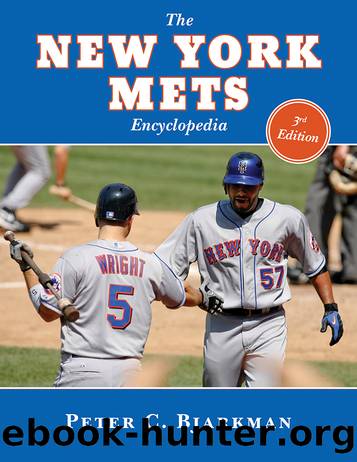The New York Mets Encyclopedia by Peter C. Bjarkman

Author:Peter C. Bjarkman
Language: eng
Format: epub
Publisher: Skyhorse Publishing
Published: 2013-01-01T00:00:00+00:00
Ed Kranepool replaced a short-lived legend and then built a long-lived legend of his own. (Brace Photo)
1981âTHE RETURN OF KINGMAN
Dave Kingman made two noteworthy arrivals in New York. The first provided the Mets with their only legitimate power hitter since the demise of Frank Thomas at the end of the ball clubâs first outing a dozen seasons earlier. Dave Kingman was purchased from the San Francisco Giants during spring training on the eve of the 1975 season for $150,000 cash with the hope that he would resolve the teamâs long-standing home run production problems. And the lanky right-handed swinger didnât disappoint in immediately filling at least some of those expectations. He improved on his earlier performances, banged over 30 homers (36) for the first time, and wiped out Thomasâs earlier team record. A season later, he broke the record again and lost the league home run crown to Mike Schmidt by the margin of a single dinger, despite missing 39 games. But after two years of pounding the baseball with Ruthian effort, the one-dimensional slugger had quickly worn out his welcome on a ball club bent on an image overhaul. In the middle of year three, Kingman was on his way back out of town, dumped from the Metsâ roster the same fateful day as Tom Seaver.
The second tour of duty with the Mets was nearly as productive for the oversized free-swinging banger with the notoriously bad attitude. But that second tour also exposed the nature of Kingmanâs limited value in any lineup bent on winning many ball games. Kingman had been picked up from the Cubs in February 1981 (for Steve Henderson and cash) at a time when Mets fortunes had dipped to an all-time post-sixties low. And there was some irony attached to his reacquisition. Kingman had, four years earlier, been dealt away on the same day Seaver had been traded to Cincinnati in exchange for promising outfielder Steve Henderson and a flock of lesser prospects. Now, as the revolving door swung again, it was Henderson who was sent out of town as the price for reacquiring Kingman. King Kong had recently reached a home run peak in Chicago, blasting a league-best 48 in 1979, but had fallen well off the pace in an injury-wrecked 1980 season. Back in New York, Kingman once more rebounded in the power department. After a strike-shortened 1981 campaign kept his numbers down, he again matched his Metsâ record of 37 dingers in 1982. But it all meant little in terms of any impact on team fortunes, with the club finishing fifth and then sixth twice during his second tenure. By 1983, the unpredictable slugger had again slumped badly, with all-time lows in homers (13), RBIs (29), and runs scored (25). He was soon dealt to Oakland, where he hit more than 30 homers in each of his final three seasons and set a still-standing record for the most round trippers ever (35) in a final season of big-league play (1986).
Download
This site does not store any files on its server. We only index and link to content provided by other sites. Please contact the content providers to delete copyright contents if any and email us, we'll remove relevant links or contents immediately.
Machine Learning at Scale with H2O by Gregory Keys | David Whiting(3984)
Never by Ken Follett(3715)
Liar's Poker by Michael Lewis(3330)
The Ultimate Backcountry Survival Manual by Aram Von Benedikt; Editors of Outdoor Life;(3191)
Will by Will Smith(2745)
The Partner by John Grisham(2324)
Friends, Lovers, and the Big Terrible Thing by Matthew Perry(2085)
Can't Hurt Me: Master Your Mind and Defy the Odds - Clean Edition by David Goggins(2079)
Taste by Kris Bryant(1820)
HBR's 10 Must Reads 2022 by Harvard Business Review(1744)
A Short History of War by Jeremy Black(1732)
Never Finished: Unshackle Your Mind and Win the War Within by David Goggins(1610)
515945210 by Unknown(1570)
The Arm by Jeff Passan(1552)
A Game of Thrones (The Illustrated Edition) by George R. R. Martin(1516)
The Dodgers by Schiavone Michael;(1496)
The Yogi Book by Yogi Berra(1460)
443319537 by Unknown(1441)
1942266391 (N) by Monte Francis(1395)
